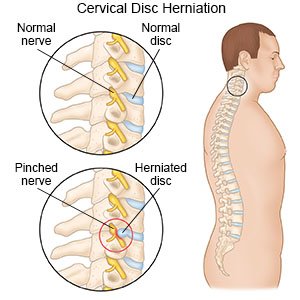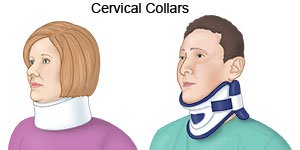Cervical Disc Herniation
Medically reviewed by Drugs.com. Last updated on Sep 23, 2025.
Cervical disc herniation (CDH) occurs when a disc bulges out from between the vertebrae (bones) in your neck. Discs are spongy cushions between the vertebrae. The bulging disc may press on your nerves or spinal cord.
 |
DISCHARGE INSTRUCTIONS:
Call your local emergency number (911 in the US), or have someone call if:
- You have sudden trouble breathing.
Return to the emergency department if:
- You lose feeling in one or both arms.
- You are suddenly not able to move your neck, or one or both arms.
- You are not able to move one or both legs.
Call your doctor if:
- You cannot control when you urinate or have a bowel movement.
- Your pain gets worse, even after you take medicine.
- Your voice suddenly becomes hoarse.
- You have trouble swallowing.
- You have questions or concerns about your condition or care.
Medicines:
You may need any of the following:
- NSAIDs , such as ibuprofen, help decrease swelling, pain, and fever. This medicine is available with or without a doctor's order. NSAIDs can cause stomach bleeding or kidney problems in certain people. If you take blood thinner medicine, always ask your healthcare provider if NSAIDs are safe for you. Always read the medicine label and follow directions.
- Prescription pain medicine may be given. Ask your healthcare provider how to take this medicine safely. Some prescription pain medicines contain acetaminophen. Do not take other medicines that contain acetaminophen without talking to your healthcare provider. Too much acetaminophen may cause liver damage. Prescription pain medicine may cause constipation. Ask your healthcare provider how to prevent or treat constipation.
- Muscle relaxers decrease pain from muscle spasms.
- Take your medicine as directed. Contact your healthcare provider if you think your medicine is not helping or if you have side effects. Tell your provider if you are allergic to any medicine. Keep a list of the medicines, vitamins, and herbs you take. Include the amounts, and when and why you take them. Bring the list or the pill bottles to follow-up visits. Carry your medicine list with you in case of an emergency.
Activity:
Your healthcare provider may have you rest in bed to prevent more injury to your neck. Ask how long you should rest and when you can return to your daily activities.
Heat:
Apply heat on your neck for 20 to 30 minutes every 2 hours for as many days as directed. Heat helps decrease pain and muscle spasms.
Ice:
Apply ice on your neck for 15 to 20 minutes every hour or as directed. Use an ice pack, or put crushed ice in a plastic bag. Cover the bag with a towel before you apply it to your skin. Ice helps prevent tissue damage and decreases swelling and pain.
Physical therapy:
A physical therapist teaches you exercises to make your neck muscles stronger. A physical therapist also teaches you stretches to decrease your pain.
A cervical collar
prevents neck movement and decreases pain. Your provider will tell you how often to use the collar and for how long.
 |
Follow up with your doctor as directed:
Write down your questions so you remember to ask them during your visits.
© Copyright Merative 2025 Information is for End User's use only and may not be sold, redistributed or otherwise used for commercial purposes.
The above information is an educational aid only. It is not intended as medical advice for individual conditions or treatments. Talk to your doctor, nurse or pharmacist before following any medical regimen to see if it is safe and effective for you.
Learn more about Cervical Disc Herniation
Care guides
Further information
Always consult your healthcare provider to ensure the information displayed on this page applies to your personal circumstances.
